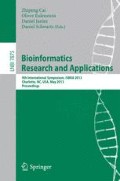Abstract
We introduce the combinatorial optimization problem Highly Connected Deletion, which asks for removing as few edges as possible from a graph such that the resulting graph consists of highly connected components. We show that Highly Connected Deletion is NP-hard and provide a fixed-parameter algorithm and a kernelization. We propose exact and heuristic solution strategies, based on polynomial-time data reduction rules and integer linear programming with column generation. The data reduction typically identifies 85 % of the edges that need to be deleted for an optimal solution; the column generation method can then optimally solve protein interaction networks with up to 5 000 vertices and 12 000 edges.
Access this chapter
Tax calculation will be finalised at checkout
Purchases are for personal use only
Preview
Unable to display preview. Download preview PDF.
References
Aloise, D., Cafieri, S., Caporossi, G., Hansen, P., Perron, S., Liberti, L.: Column generation algorithms for exact modularity maximization in networks. Physical Review E 82, 046112 (2010)
Berardini, T.Z., Mundodi, S., Reiser, R., Huala, E., Garcia-Hernandez, M.: et al. Functional annotation of the Arabidopsis genome using controlled vocabularies. Plant Physiology 135(2), 1–11 (2004)
Boyle, E.I., Weng, S., Gollub, J., Jin, H., Botstein, D., Cherry, J.M., Sherlock, G.: GO:TermFinder–open source software for accessing gene ontology information and finding significantly enriched gene ontology terms associated with a list of genes. Bioinformatics 20(18), 3710–3715 (2004)
Chang, W.-C., Vakati, S., Krause, R., Eulenstein, O.: Exploring biological interaction networks with tailored weighted quasi-bicliques. BMC Bioinformatics 13(S-10), S16 (2012)
Chartrand, G.: A graph-theoretic approach to a communications problem. SIAM Journal on Applied Mathematics 14(4), 778–781 (1966)
Chekuri, C., Goldberg, A.V., Karger, D.R., Levine, M.S., Stein, C.: Experimental study of minimum cut algorithms. In: Proc. 8th SODA, pp. 324–333 (1997)
van Dongen, S.: Graph Clustering by Flow Simulation. PhD thesis, University of Utrecht (2000)
Hartuv, E., Shamir, R.: A clustering algorithm based on graph connectivity. Information Processing Letters 76(4-6), 175–181 (2000)
Hartuv, E., Schmitt, A.O., Lange, J., Meier-Ewert, S., Lehrach, H., Shamir, R.: An algorithm for clustering cDNA fingerprints. Genomics 66(3), 249–256 (2000)
Hayes, W., Sun, K., Pržulj, N.: Graphlet-based measures are suitable for biological network comparison. Bioinformatics (to appear, 2013)
Jiang, D., Pei, J.: Mining frequent cross-graph quasi-cliques. ACM Transactions on Knowledge Discovery from Data 2(4), 16:1–16:42 (2009)
Koyutürk, M., Szpankowski, W., Grama, A.: Assessing significance of connectivity and conservation in protein interaction networks. Journal of Computational Biology 14(6), 747–764 (2007)
Liu, H., Zhang, P., Zhu, D.: On editing graphs into 2-club clusters. In: Snoeyink, J., Lu, P., Su, K., Wang, L. (eds.) AAIM 2012 and FAW 2012. LNCS, vol. 7285, pp. 235–246. Springer, Heidelberg (2012)
Niedermeier, R.: Invitation to Fixed-Parameter Algorithms. OUP (2006)
Parker, B.J., Moltke, I., Roth, A., Washietl, S., Wen, J., Kellis, M., Breaker, R., Pedersen, J.S.: New families of human regulatory RNA structures identified by comparative analysis of vertebrate genomes. Genome Research 21(11), 1929–1943 (2011)
Ronhovde, P., Nussinov, Z.: Local resolution-limit-free Potts model for community detection. Physical Review E 81(4), 046114 (2010)
Shamir, R., Sharan, R., Tsur, D.: Cluster graph modification problems. Discrete Applied Mathematics 144(1-2), 173–182 (2004)
Stark, C., Breitkreutz, B.-J., Chatr-aryamontri, A., Boucher, L., Oughtred, R., et al.: The BioGRID interaction database: 2011 update. Nucleic Acids Research 39, 698–704 (2011)
van Rooij, J.M.M., van Kooten Niekerk, M.E., Bodlaender, H.L.: Partition into triangles on bounded degree graphs. Theory of Computing Systems (to appear, 2013)
Wang, J.Z., Du, Z., Payattakool, R., Yu, P.S., Chen, C.-F.: A new method to measure the semantic similarity of GO terms. Bioinformatics 23(10), 1274–1281 (2007)
Author information
Authors and Affiliations
Editor information
Editors and Affiliations
Rights and permissions
Copyright information
© 2013 Springer-Verlag Berlin Heidelberg
About this paper
Cite this paper
Hüffner, F., Komusiewicz, C., Liebtrau, A., Niedermeier, R. (2013). Partitioning Biological Networks into Highly Connected Clusters with Maximum Edge Coverage. In: Cai, Z., Eulenstein, O., Janies, D., Schwartz, D. (eds) Bioinformatics Research and Applications. ISBRA 2013. Lecture Notes in Computer Science(), vol 7875. Springer, Berlin, Heidelberg. https://doi.org/10.1007/978-3-642-38036-5_13
Download citation
DOI: https://doi.org/10.1007/978-3-642-38036-5_13
Publisher Name: Springer, Berlin, Heidelberg
Print ISBN: 978-3-642-38035-8
Online ISBN: 978-3-642-38036-5
eBook Packages: Computer ScienceComputer Science (R0)

